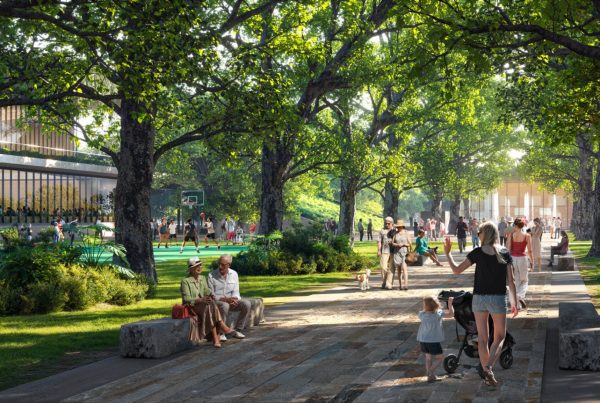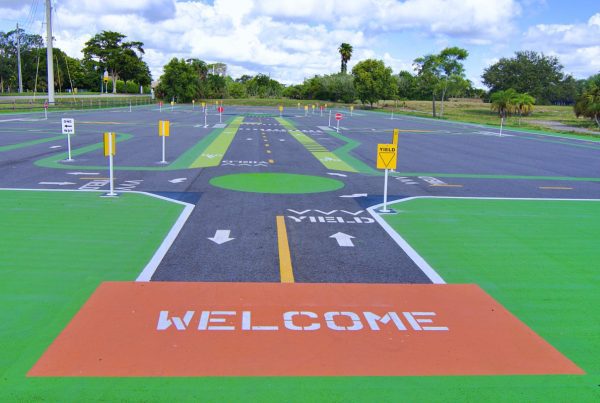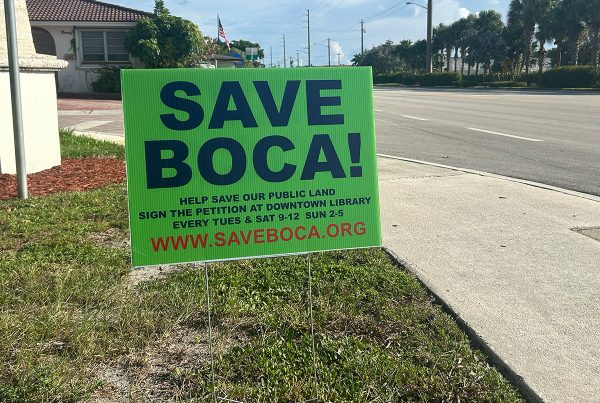Public schools very quickly have become a political issue in Boca Raton. With four of the city’s five elected officials running for something—and with two related items on the agenda for tonight’s meeting—there’s potential for good but also for harm.
The good could come from a revived education task force that separates reality from myth on school crowding and spending. Good also could come from a donation of land for a new elementary school.
The harm could come from a prolonged discussion on a location for the new Addison Mizner Elementary School. If the city can’t resolve that issue soon enough, there might not be a new Addison Mizner Elementary. Wrongly blaming school crowding on “overdevelopment” also could lead the council into some bad decisions.
Let’s take the Addison Mizner issue first.
To recap, there’s roughly $20 million in the school district’s sales-tax surcharge plan for a new Addison Mizner. There’s a similar amount for a new Verde Elementary, west of Town Center Mall.
But the current Addison Mizner site, on Southwest 12th Avenue in Boca Square, is small by district standards. The district also wants to add middle-school grades, to relieve crowding at Boca Middle to the north.
Rebuilding on 12th Avenue also would require moving Addison Mizner students to the old Verde campus for 18 months after the new Verde opens. That could cause major traffic problems on Verde Trail.
Last summer, the city began checking alternative locations for Addison Mizner. At this point, the only possibility is acreage on the southeast corner of Sugar Sand Park, which the Greater Boca Raton Beach and Park District owns.
Here’s a breakdown of the two scenarios:
MOVING ADDISON MIZNER
- Why it could work: The school gets more room for the added three grades. Traffic backups on 12th Avenue at pickup and dropoff go away. The acreage at Sugar Sand for buildings wouldn’t be that much more, but the school could use the fields at Sugar Sand.
- Why it wouldn’t work: Residents of Boca Sailing and Racquet Club, which is across Camino Real from the Sugar Sand site, oppose the move because of traffic the school would bring. They have threatened to sue if the school district moves Addison Mizner. It’s an affluent community whose residents include Bonnie Miskel, a land-use attorney who appears often before the council.
To use the Sugar Sand land, the city council would have to lift a conservation easement on the property. The bigger legal issues, though, are deed restrictions. One limits the site to recreational use. Another limits access.
In addition, the district wants compensation for the Sugar Sand land. The city might have to pay the school district for the roughly 11-acre Addison Mizner site in Boca Square, to prevent the property from being developed.
KEEPING ADDISON MIZNER
- Why it could work: Boca Square keeps a walkable, neighborhood school. There’s no uncertainty about what happens to the site. The school district buys two or three adjacent properties, thus allowing the city to better manage school traffic. The city doesn’t have the unplanned expense of buying the Addison Mizner property.
- Why it wouldn’t work: Despite their best efforts, school district designers find themselves unable to fit nine grades onto the site. Some neighbors already worry that the school would have to be three stories tall. Traffic issues become overwhelming because Boca Square residents object to widening 12th Avenue. Verde parents and Via Verde residents pressure the council over their own potential traffic issues.
Both scenarios appear to be more unworkable than workable. But there is a third scenario.
The city council will vote tonight on a resolution regarding a donation to the school district of about 15 vacant acres next to Estridge High Tech Middle School west of Spanish River Athletic Park. The sales tax money and boundary shifts will allow the district to reduce crowding at Boca Raton’s high schools and middle schools, but not at elementary schools. The city would offer this land for a new elementary school, money for which is already in the budget.
The opportunity became available when a donation from a homebuilder for land near West Palm Beach didn’t materialize. Under this scenario, Boca Raton would donate the land, for which the city has no plans. The school would include middle-school grades, to relieve crowding at Boca Middle. Addison Mizner would remain a K-5 school at its current location. Students would attend the new school during rebuilding of Addison Mizner.
Under that scenario, Verde’s traffic problem would go away. So would the problem of a three-story building in the Addison Mizner neighborhood. So would a lawsuit over using Sugar Sand Park as a school.
Scott Singer proposed the resolution. He’s running for mayor in what would be a special election next March, and his latest newsletter touts the proposal and his work on education. Mayor Susan Haynie is meeting today with School Superintendent Robert Avossa and Frank Barbieri—the school board member who represents Boca Raton—about that third scenario.
Oops! We could not locate your form.
Boca Raton must resolve this issue quickly. If other areas would love that elementary school, they also would love that money for Addison Mizner. If the debate drags on, Barbieri’s colleagues could shift the $20 million. That’s why the move to Sugar Sand Park is so problematic. Even unsuccessful litigation could last a year.
I will update as soon as developments warrant.
Yamato Road townhouses
Before council members get to that resolution about land for a school they will hear an item that did much to start the discussion about school crowding.
It’s the proposal—requiring two ordinances and three resolutions—for 20 townhouses on Yamato Road just east of Interstate 95. To allow Yamato Villas, the council would have to approve a land-use change and a rezoning. Neighbors object to the change from single-family homes and argue that college students would live there. City planners say multi-family housing makes more sense for the roughly 2-acre site.
When the council first heard this proposal in late November, Councilwoman Andrea O’Rourke said any students from the townhomes would attend Boca Raton Middle. As noted in the first item, the school is over capacity. O’Rourke said Boca Middle could not take even one student from Yamato Villas.
In fact, as the council heard later, cities cannot reject development projects if they add too many students. The Legislature prohibited school concurrency—having enough classroom space when projects open. Council members also heard from school district planners that the main cause of crowding is younger families moving into the city, not approval of specific, major developments.
The council postponed a vote on Yamato Villas in November, taking pains to say members had issues in addition to schools. There may be reasons to deny approval, but the council would take a big risk by linking denial to the impact on schools.
Delray’s school problems
As Delray Beach commissioners heard last week, their city schools have the opposite problem from Boca Raton—too few students.
Carver Middle, for example, is at just 53 percent of capacity. Elementary schools average 73 percent of capacity. Atlantic High School is nearly full—93 percent— but that compares to Boca Raton High School, which the district says is near 20 percent over capacity.
According to Delray Beach’s education board, which made the presentation, the city needs to attract middle-class students back to the schools. Doing so will require a “branding” effort and creative use of the roughly $42 million city schools will receive from the sales-tax plan. This could involve “realigning” some schools.
The presentation underscored the importance of the education board to Delray Beach. After learning about crowding in city schools, the Boca Raton City Council voted to appoint a new, seven-member education task force. No members have been appointed.
Are sober houses the problem? And rebranding may help
Mayor Cary Glickstein had an interesting take on that decline of middle-school students in Delray Beach. He blames much of it on sober houses.
During the Great Recession, home prices sank. Sober house operators bought up many properties in Delray Beach. Though some were owner-occupied, Glickstein said, middle-class families were renting many of the others. As the city’s efforts to push out bad sober house operators continue, Glickstein believes that some of those middle-class families will come back.
Glickstein also is adding to that “branding” effort for Delray Beach schools. With a $100,000 foundation grant, he hopes the city and school district can create a program under which students can earn their high school diploma with training to begin work in the medical arts field. Glickstein said Delray Beach Medical Center, the city’s largest employer, is participating.
Downtown campus plan on agenda
On the agenda for tonight’s Boca Raton City Council regular meeting is approval of a contract with the consultant on the downtown campus plan. Song & Associates will help to develop the components of the plan based on further public comment.
The company has held public meetings that revealed, among other things, the wish for a performing arts center in the area around City Hall and the Downtown Library. The goal of this phase is to create a master plan for the roughly 30 acres. City Manager Leif Ahnell said the Phase 2 contract cost would not exceed $363,000.
And Midtown
Also on the Boca Raton City Council agenda is a final vote on the proposals that would govern development of the Midtown neighborhood. At this point, I see no change in the staff recommendations for the ordinances or any change in the developers’ differences with the staff.
Another letter from Midtown property owners warns of a lawsuit if the city links development approvals to the opening of a Tri-Rail station. The proposal would allow up to 2,500 residential units on the 300 acres of Midtown. Current rules prohibit residential.
That school crowding issue also may arise during the Midtown discussion. Opponents have argued that new development would overwhelm schools. Not only can the city council not consider schools in its decision, the idea of a new elementary school not far away introduces a new element to the discussion.
Brightline weighs in
All Aboard Florida held an odd news conference Friday morning in Boca Raton about recent deaths at crossings from the company’s Brightline passenger trains.
The company came off like a lawyer that goes into court with a slam-dunk case and then tries to lose it. Brightline trotted out local officials—Mayor Haynie among them—to stress the need for safety. All participants wore stickers saying, “Stay Off Train Tracks.”
After the prepared remarks at the city’s historic train depot, though, Brightline CEO Patrick Goddard took questions for less than 10 minutes before ending the session. The occasion called for answering every question until reporters gave up.
Obviously, Brightline must be diplomatic when stating the obvious: People who go around gates trying to beat a train pose the risk to themselves, not Brightline. Goddard noted that the deaths were preventable.
Still, Brightline has many opponents, especially north of Palm Beach County, who oppose the service. U.S. Rep. Brian Mast, who represents that area, is up for reelection and can score points by calling for an investigation. So can Sen. Bill Nelson, who’s seeking a fourth term this year.
Brightline also irritated local officials and people who live near the track by promising regularly that quiet zone improvements would be in place when service started. In fact, those improvements are not done.
Brightline probably will come through this controversy with only modest damage at best. But the company’s behavior Friday was puzzling. You wonder if Brightline realizes the political threat it faces.








“Residents of Boca Sailing and Racquet Club, which is across Camino Real from the Sugar Sand site, oppose the move because of traffic the school would bring. ”
Except that not one single, solitary car from the added traffic will appear on the surface streets of their precious “affluent community” as they do now, in my neighboorhood, with the current AMES carline meandering through where my family and I walk daily to/from school, dodging inconsiderate parents ignoring posted traffic signs, speed limits, and endangering pedestrians in general.
I love how politicians like scott singer talk about public schools with such expertise when they dont even send their own children to public school. Someone should ask Singer and co. if the new school is built, will they send their own kids?
What expertise does Singer have in public education? His kids go to private school.